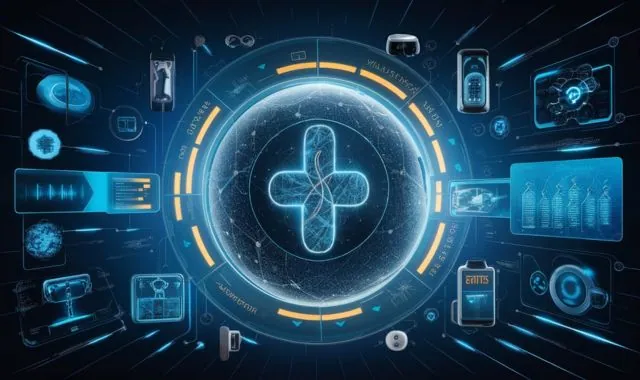Physical Address
304 North Cardinal St.
Dorchester Center, MA 02124

Health Tech Revolution healthcare by offering remote care, data-driven diagnostics, and improved patient engagement. From wearables to AI, it empowers patients and streamlines operations. Challenges like data privacy and accessibility require solutions, but Health Tech holds immense promise for a future of accessible, efficient healthcare.

For decades, the healthcare landscape has relied on traditional methods. But a revolution is brewing, driven by the transformative power of technology. This article explores the exciting world of Health Tech, its impact on how we approach healthcare, and the challenges that lie ahead.
Traditional healthcare systems often face limitations in accessibility, efficiency, and affordability. Health Tech emerges as a response to this need, leveraging technology to improve care delivery.
From remote consultations to data-driven diagnostics, Health Tech offers a plethora of tools to empower patients, optimize healthcare operations, and ultimately, revolutionize the way we care for ourselves and others.
The Health Tech landscape thrives on a diverse range of innovations, each playing a crucial role:
Telehealth platforms connect patients and doctors virtually, eliminating geographical barriers and increasing access to care, especially in remote areas.
Wearable devices track your heart rate, sleep patterns, and activity levels, providing valuable data for health monitoring and promoting a preventive approach to wellness.
AI algorithms are transforming healthcare by analyzing vast amounts of medical data to identify patterns, predict disease risks, and personalize treatment plans.
Robotic surgery offers minimally invasive procedures with enhanced precision and faster recovery times, leading to better patient outcomes.
The benefits of Health Tech extend far beyond the realm of gadgets and apps. Here’s a glimpse into its multifaceted impact:
AI-powered diagnostics can analyze medical scans and patient data to detect diseases in their early stages, enabling personalized treatment plans tailored to individual needs.
Wearable devices and remote monitoring systems allow healthcare providers to keep a watchful eye on patients’ health vitals remotely, facilitating timely intervention if needed.
Health Tech platforms empower patients to actively participate in their care journey by providing access to medical records, appointment scheduling, and online consultations.
Repetitive tasks like appointment scheduling and insurance verification can be automated using Health Tech solutions, freeing up valuable time for medical professionals to focus on patient care.
By harnessing the power of healthcare data, administrators can gain valuable insights into resource allocation, patient flow, and overall healthcare delivery, leading to more efficient operations.
Health Tech can contribute to cost reduction in healthcare by enabling early disease detection, remote monitoring, and streamlined operations, ultimately benefiting both patients and healthcare institutions.
Despite its immense potential, Health Tech faces certain challenges that need to be addressed:
Protecting sensitive patient data is paramount. Robust security measures and clear data privacy regulations are crucial to ensure trust and adoption.
Not everyone has equal access to technology or digital literacy. Efforts are needed to bridge the digital divide and ensure everyone benefits from Health Tech advancements.
As AI plays an increasing role in healthcare, ethical considerations regarding bias, transparency, and the human element in medicine need to be carefully addressed.

The potential of Health Tech is vast, but its success hinges on active participation. Here are some ways you can get involved:
Consider using a fitness tracker or smartwatch to monitor your health vitals and activity levels. Share this data with your doctor to gain insights into your overall well-being.
If geographical distance or scheduling conflicts pose a challenge, consider virtual consultations with qualified healthcare providers.
Share your positive experiences with Health Tech with friends and family. Encourage open conversations about its potential to improve healthcare access and outcomes.
Stay informed about policies related to data privacy, telehealth regulations, and equitable access to Health Tech solutions. Voice your support for initiatives that promote responsible and inclusive advancements in healthcare technology.

Healthcare is undergoing a paradigm shift, driven by the transformative power of technology. By working together – patients, healthcare providers, policymakers, and technology developers – we can harness the potential of Health Tech to create a future where healthcare is accessible, efficient, and empowers individuals to take charge of their well-being.
Here are some frequently asked questions about Health Tech:
Not everyone has access to reliable internet connections or the digital literacy required to use certain Health Tech solutions.
While Health Tech can lead to cost reductions in the long run, the initial investment in technology and infrastructure can be substantial.
Ensuring the security of sensitive patient data is a constant challenge.
Health Tech can be safe when implemented with robust security measures and clear data privacy regulations. However, it’s crucial to be cautious about the apps and devices you use, and to only share your health data with trusted healthcare providers and platforms.
No, Health Tech is not meant to replace doctors. Instead, it aims to empower them by providing them with valuable tools for diagnosis, treatment planning, and patient monitoring.
There are many ways to get involved with Health Tech! You can start by using a fitness tracker, exploring telehealth options for consultations, or simply familiarizing yourself with the different Health Tech solutions available.
The Health Tech landscape is vast and ever-evolving. Some of the key players include:
Offering virtual consultations with healthcare providers.
Creating devices that track health vitals and activity levels.
Building algorithms to analyze medical data and support healthcare decisions.
Developing robotic surgical systems for minimally invasive procedures.